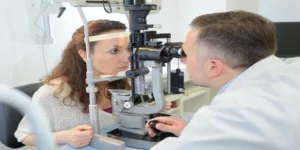When it comes to children, figuring out eye problems can be problematic, especially when they are very young. Because children often can’t vocalize or even comprehend what they literally can’t see, they have no basis for comparison to know if there is a problem, leaving a parent with few signs unless the problem is significant enough to send up red flags. Vision problems can often go undiagnosed until a child reaches kindergarten, when a formal test is done. In the meantime, development can suffer if a child does not see correctly and it can limit their capacity to reach their full potential.
When it comes to eye problems, things like “pink eye” are easy to observe. A child’s eye becomes red and irritated and it prompts you to seek medical attention, but more subtle eye conditions don’t always surface or show. That is why checkups are critical throughout a youngster’s life, not just when they enter kindergarten. There are also small things that you can look for that can help to get your child the help they need when they need it, so that problematic issues aren’t overlooked.
Many parents assume that when it comes to vision, if there doesn’t seem to be a problem, there isn’t one. But that thought process can end up costing your child big time. Very few parents understand the importance of getting their child’s eyes checked on a regular basis, and if it isn’t a part of their health benefits coverage, they might opt to wait before visiting professionals like Eyes in the Village. If you see any of these conditions surfacing, or even suspect them, then it is critical to go to an ophthalmologist and have them make sure that there isn’t some underlying problem.
Eyelid stye
An eyelid stye is a tiny infection that can appear on your child’s eyelid. Styes are a type of infection caused by the build-up of specific bacteria in the glands that are located on the eyelid. Although not usually harmful to the eye or vision, they can be extremely painful and irritating. While most styes will resolve on their own without medical intervention, if it does not go away, then you should seek medical advice. Generally, a stye can be cured by massage and using warm compresses. Just make sure that you are using sterile things when dealing with your child’s eye.
Dry eye
More school-aged children are being diagnosed with chronic dry eye conditions than ever before. Although typically associated with contact lenses, many children are being afflicted with chronic dry eyes from excessive screen time. Symptoms of dry eye can include red and irritated eyes. When children are staring at a screen, they blink 50% less than when they aren’t, which can lead to their eyes being chronically dry. Artificial tears are often a great solution, but the best one – for many reasons – is to limit their screen time. If the condition is persistent, then it is worth a trip to have a vision specialist rule out other causes.
Convergence insufficiency
Convergence insufficiency is when a child’s eye is weak and it cannot turn inward completely, specifically when the child is looking at things close up. CI can lead to things like chronic headaches, tired and watery eyes, reading difficulties, and can impact a child’s overall development. The good news is that CI can be detected with a regular eye exam.
Amblyopia
Amblyopia is usually called “lazy eye.” It is when one eye has a diminished vision capacity due to a vision-related development in the brain. The causes can be an extreme difference between the prescriptions of each eye. Usually, it goes undiagnosed until the other eye begins to compensate. If it is detected early on, it is correctable. Most children with amblyopia can overcome their lazy eye through treatment that allows the brain to develop correctly to compensate.
Dyslexia and visual processing
Often the symptoms of dyslexia and visual processing are very similar. Dyslexia, however, is not a problem with a child’s vision; it is a problem of the brain’s processing ability. Visual problems come from a child’s vision. They are different conditions that need to be targeted in differing ways to be corrected. That is why having an evaluation is so critical. If you notice that your child is reversing their letters or their numbers or they are having a hard time with the beginnings of words, it is imperative to have an evaluation by a vision specialist to rule out any visual processing issues.
Often childhood vision problems go undiagnosed because they aren’t identified early on. The best way to ensure that your child’s development is at its highest potential is to have early and frequent eye exams. Also, if you notice anything problematic, don’t discount it. It is always best to rule things out instead of assuming that it is nothing.








